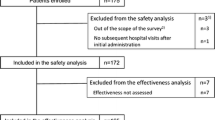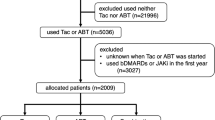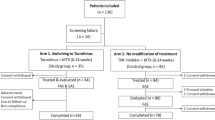Abstract
The aim of this study was to prospectively evaluate the efficacy and safety of tacrolimus for treating rheumatoid arthritis (RA) patients in clinical practice. Fifty-five active RA patients who had been resistant or intolerant to other disease-modifying antirheumatic drugs were enrolled in this open-label trial. Patients were administered tacrolimus at a dosage of 1, 2 or 3 mg once daily, and followed up for 24 weeks. They were divided into three groups according to their dosage. Efficacy and safety were evaluated utilizing clinical and laboratory findings. Eighty percent of the patients had moderate or high disease activity; 55% were elderly and 53% had complications; 65% of the patients were started on tacrolimus as a monotherapy. Moderate or good response rates were achieved as follows: 38.2% (4 weeks); 41.8% (12 weeks); and 45.6% (24 weeks). Adverse events were observed in seven cases (12.7%). Only one case required hospitalization due to severe hyperglycemia caused by a high tacrolimus concentration (24.2 ng/ml); we suspected a drug interaction in this subject. Mean concentrations were dose-dependent in the 1, 2, and 3 mg/day groups (2.96, 4.29, and 8.32 ng/ml, respectively). Four cases of high concentration (over 10 ng/ml), without any signs or symptoms, were observed in the 3 mg/day group; in these cases, doses were decreased and no severe adverse events occurred. Tacrolimus was found to be both effective and safe in treating active RA patients with complicated backgrounds in clinical practice. Blood concentration measurements and dose adjustments should be performed to prevent severe adverse events in a 3 mg/day group.


Similar content being viewed by others
References
O’Dell JR (2004) Therapeutic strategies for rheumatoid arthritis. N Engl J Med 17;350(25):2591–602
McInnes IB, Schett G (2007) Cytokines in the pathogenesis of rheumatoid arthritis. Nat Rev Immunol 7(6):429–442. doi:10.1038/nri2094
Takeuchi T (2007) Treatment of inflammatory immunologic disease 3. Anti-TNF therapy in rheumatoid arthritis. Intern Med 46(16):1311–1312. doi:10.2169/internalmedicine.46.1913
Siekierka JJ, Sigal NH (1992) FK-506 and cyclosporin A: immunosuppressive mechanism of action and beyond. Curr Opin Immunol 4(5):548–552. doi:10.1016/0952-7915(92)90024-9
Sakuma S, Kato Y, Nishigaki F, Sasakawa T, Magari K, Miyata S, Ohkubo Y, Goto T (2000) FK506 potently inhibits T cell activation induced TNF-alpha and IL-1beta production in vitro by human peripheral blood mononuclear cells. Br J Pharmacol 130(7):1655–1663. doi:10.1038/sj.bjp.0703472
Sakuma S, Kato Y, Nishigaki F, Magari K, Miyata S, Ohkubo Y, Goto T (2001) Effects of FK506 and other immunosuppressive anti-rheumatic agents on T cell activation mediated IL-6 and IgM production in vitro. Int Immunopharmacol 1(4):749–757. doi:10.1016/S1567-5769(01)00008-X
Gremillion RB, Posever JO, Manek N, West JP, van Volen-Hoven RF (1999) Tacrolimus (FK506) in the treatment of severe, refractory rheumatoid arthritis: initial experience in 12 patients. J Rheumatol 26(11):2332–2336
Furst DE, Saag K, Fleischmann MR, Sherrer Y, Block JA, Schnitzer T, Rutstein J, Baldassare A, Kaine J, Calabrese L, Dietz F, Sack M, Senter RG, Wiesenhutter C, Schiff M, Stein CM, Satoi Y, Matsumoto A, Caldwell J, Harris RE, Moreland LW, Hurd E, Yocum D, Stamler DA (2002) Efficacy of tacrolimus in rheumatoid arthritis patients who have been treated unsuccessfully with methotrexate: a six-month, double-blind, randomized, dose-ranging study. Arthritis Rheum 46(8):2020–2028. doi:10.1002/art.10427
Kremer JM, Habros JS, Kolba KS, Kaine JL, Borton MA, Mengle-Gaw LJ, Schwartz BD, Wisemandle W, Mekki QA, Tacrolimus-Methotrexate Rheumatoid Arthritis Study Group (2003) Tacrolimus in rheumatoid arthritis patients receiving concomitant methotrexate: a six-month, open-label study. Arthritis Rheum 48(10):2763–2768. doi:10.1002/art.11257
Yocum DE, Furst DE, Kaine JL, Baldassare AR, Stevenson JT, Borton MA, Mengle-Gaw LJ, Schwartz BD, Wisemandle W, Mekki QA, Tacrolimus Rheumatoid Arthritis Study Group (2003) Efficacy and safety of tacrolimus in patients with rheumatoid arthritis: a double-blind trial. Arthritis Rheum 48(12):3328–3337. doi:10.1002/art.11363
Kondo H, Abe T, Hashimoto H, Uchida S, Irimajiri S, Hara M, Sugawara S (2004) Efficacy and safety of tacrolimus (FK506) in treatment of rheumatoid arthritis: a randomized, double blind, placebo controlled dose-finding study. J Rheumatol 31(2):243–251
Yocum DE, Furst DE, Bensen WG, Burch FX, Borton MA, Mengle-Gaw LJ, Schwartz BD, Wisememandle W, Mekki QA, Tacrolimus RA Study Group (2004) Safety of tacrolimus in patients with rheumatoid arthritis: long-term experience. Rheumatology 43(8):992–999. doi:10.1093/rheumatology/keh155
Kawai S, Yamamoto K (2006) Safety of tacrolimus, an immunosuppressive agent, in the treatment of rheumatoid arthritis in elderly patients. Rheumatology 45(4):441–444. doi:10.1093/rheumatology/kei172
Kawai S, Hashimoto H, Kondo H, Murayama T, Kiuchi T, Abe T (2006) Comparison of tacrolimus and mizoribine in a randomized, double-blind controlled study in patients with rheumatoid arthritis. J Rheumatol 33(11):2153–2161
Curran MP, Perry CM (2005) Tacrolimus: in patients with rheumatoid arthritis. Drugs 65(7):993–1001. doi:10.2165/00003495-200565070-00005
Conflict of interest statement
None.
Author information
Authors and Affiliations
Corresponding author
Electronic supplementary material
Below is the link to the electronic supplementary material.
296_2008_833_MOESM1_ESM.pdf
Supplementary Figure 1: Efficacy in each patient according to the initial dose. Changes of DAS28-3CRP after 4, 12 and 24 weeks from baseline in 1, 2, and 3mg/day of TAC groups are shown. Number of patients in each group at 4, 12 and 24 weeks were 7(4W), 35(12W), and 13(24W) in 1mg group; 7(4W), 29(12W), and 11(24W) in 2mg group; and 7(4W), 23(12W), and 9(24W) in 3mg group. Closed circles show each patient and closed bars show mean values. Statistical significance was evaluated by non-repeated measures of ANOVA. (PDF 38 KB)
296_2008_833_MOESM2_ESM.pdf
Supplementary Figure 2: Efficacy in each patient according to combination of DMARDs. Mean value and standard deviation of DAS28-3CRP at 4, 12 and 24 weeks in TAC with no DMARDs, with MTX combination, and with other DMARDs, were shown by black, gray, and white bars. Number of patients in each group at 0, 4, 12 and 24 weeks were 36(0W), 36(4W), 29(12W), and 23(24W) in the TAC with no DMARDs group; 11(0W), 11(4W), 11(12W), and 10(24W) in the MTX combination group; and 9(0W), 9(4W), 8(12W), and 7(24W) in other DMARDs group. Statistical significance was evaluated by non-repeated measures of ANOVA. (PDF 20.6 KB)
296_2008_833_MOESM3_ESM.pdf
Supplementary Table 2: Nomenclature of initial combination of DMARDs with TAC and their number of patients. (PDF 27.5 KB)
Rights and permissions
About this article
Cite this article
Suzuki, K., Kameda, H., Amano, K. et al. Single center prospective study of tacrolimus efficacy and safety in treatment of rheumatoid arthritis. Rheumatol Int 29, 431–436 (2009). https://doi.org/10.1007/s00296-008-0833-z
Received:
Accepted:
Published:
Issue Date:
DOI: https://doi.org/10.1007/s00296-008-0833-z




